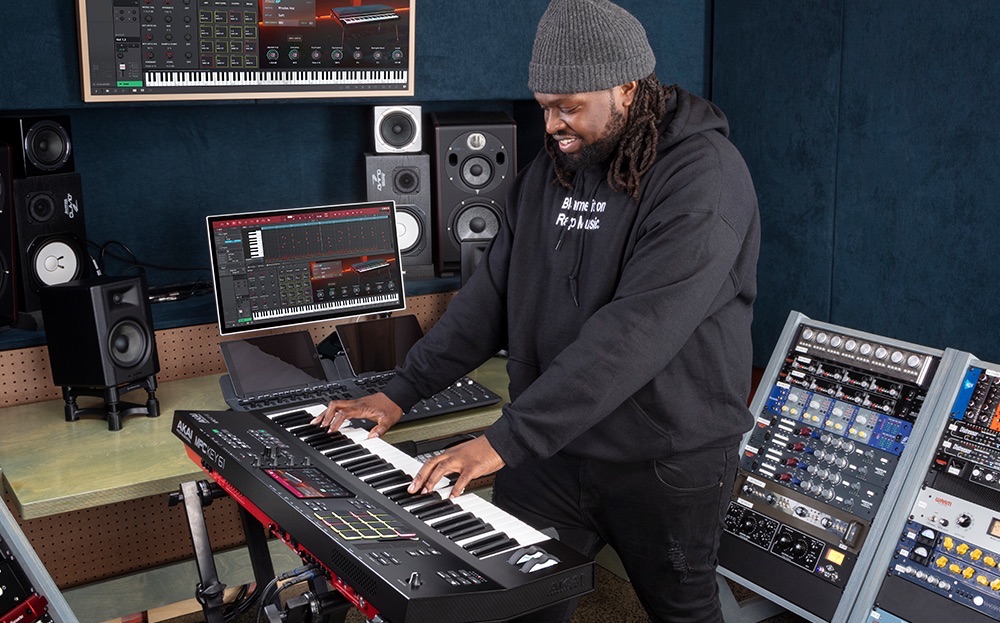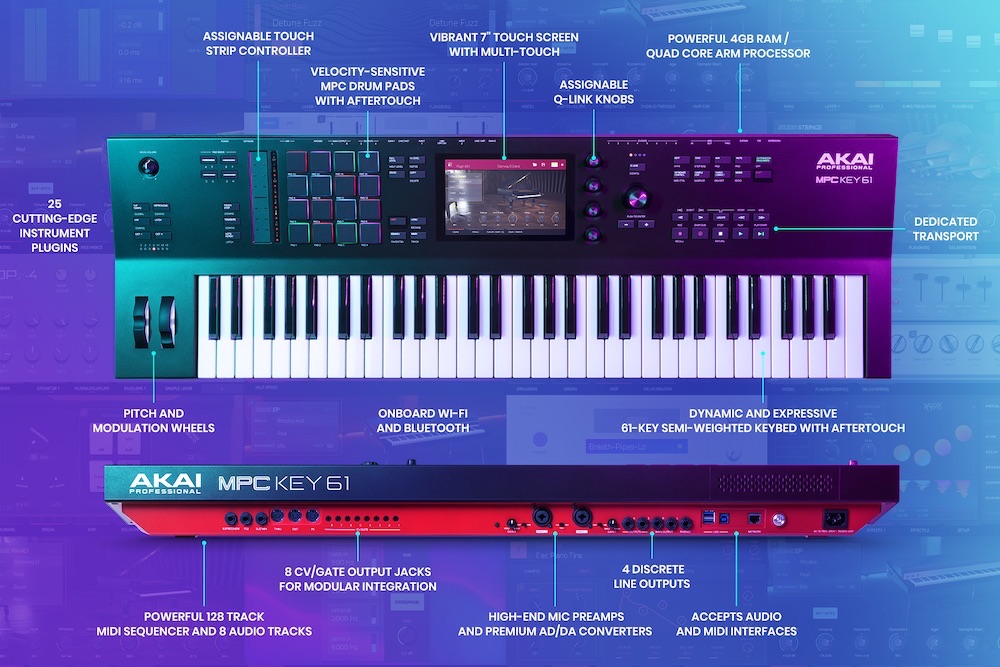Akai’s first MPC with a built-in keyboard proves much more than the sum of its parts. Greg Scarth finds out why this might be your favourite new workstation.

Back in its original 80s incarnation, the Akai MPC was a fairly simple concept: combine a sampler with a built-in sequencer, a band of performance pads and some basic effects, that’s pretty much it. Over the decades, the MPC platform has grown into something much more advanced, with an increased focus on synthesis alongside the much-expanded sampling power, plus a frequently updated sequencer and audio recorder which have effectively turned the latest MPCs into standalone DAWs.
With the MPC Key 61, Akai have ventured into new territory. The brand produced a few keyboard-based samplers back in the 80s and 90s, but the MPC series has always been strictly centred around that iconic 4×4 bank of touch-sensitive performance pads. The Key 61 retains the pads, but the focus here is the keyboard, a first for an MPC.
Out of the box, the Key 61 is an impressive bit of kit, built around that full-size, semi-weighted, aftertouch keyboard and a slanted front panel above which presents you with the pads alongside the 7-inch, full-colour, multi-touch screen. Build quality is as solid as you’d expect from Akai; the Key 61 is a weighty beast despite being made of plastic. Akai are masters of the user interface at this point, and the layout of the controls is as immediate and intuitive as you’d expect, with an assignable touch strip for expression alongside more conventional options like the touch-sensitive Q-Link encoders plus the traditional pitch bend and mod wheel.
At nearly a meter wide and over eight kilograms, the Key 61 isn’t really a portable instrument like most MPCs (although if you stuck it in a flight case it’d make a hell of a centrepiece for a live rig). Instead it’s definitely a studio powerhouse. In terms of specs, the Key 61 packs 32 GB of internal storage and 4 GB of RAM, with a huge 13 GB of pre-installed content including samples and exclusive sounds from the likes of Loopmasters and Toolroom Records. There are similarities with the MPC Live here, of course, but you’d be mistaken for thinking the Key 61 is just a Live with a keyboard grafted on. The hardware spec is slightly improved, but the software is also updated to reflect the different approach, integrating the keyboard seamlessly with the existing MPC OS.

Sonically, MPCs have always been all-rounders, but the development of Akai’s own instruments. Fabric XL is the newly updated flagship synth engine, and it’s a proper all-rounder, based on a dual-layer sample-based approach. In terms of the basics, the Key 61 ticks all the boxes for sampling, but the overlap between individual hits, sample-based instruments, audio recordings and virtual instruments now feels impressively cohesive; the pads still feel like a natural starting point for programming drums, but more serious keyboard players will be able to take advantage of the keyboard split and layering options to create a much more expressive hands-on instrument than any previous MPC. Interestingly, some of the Key 61’s new factory drum kits take advantage of the keyboard setup to offer extended ranges of sounds, including melodic options and loops. Load the new 808 kit, for example, and you can play the kicks melodically across an octave while also programming other hits. It’s not necessarily something you couldn’t achieve on any other MPC, but it’s undoubtedly quicker and easier than ever before.
It’s worth mentioning the excellent connectivity options on the back panel here, too, which allow you to integrate other instruments and external hardware synths with the Key 61’s internal sound engine. As well as an array of audio inputs and outputs and Ethernet for wired connectivity (in addition to built-in Wi-Fi), you’ll also find DIN sockets for MIDI plus eight assignable ⅛-inch sockets for CV and gate outputs, allowing you to control Eurorack modular gear or other patchable semi-modular instruments. Versatile stuff.

Above all else, what impresses about the MPC Key 61 is the way it feels like a cohesive, all-in-one production environment which allows you to make music in whichever way suits you best. The excellent keyboard integration makes the Key 61 much more intuitive than, say, an MPC Live II hooked up to a MIDI keyboard. As such, it feels more like the Key 61 competes with other workstations than necessarily with traditional samplers. There are some seriously good samplers at relatively affordable prices now, such as the Roland SP-404MKII and Sonicware SmplTrek, but the Key 61 is altogether more expansive and arguably more creatively inspiring thanks to its seamless integration of all those strengths: sampling, synths, sequencing and creative workflow. As such, it arguably compares more closely to synth-based workstations like the Korg Nautilus or Roland Fantom-07, both of which come from a more live performance-focused angle than the more studio-centric Key 61.

The MPC series stopped being ‘just’ samplers a long time ago – if they ever really were. The basic concept of sampling and sequencing has evolved into something almost uncategorisable, combining class-leading sample options with huge virtual instrument capabilities, excellent sequencing and top quality effects. The Key 61 is clearly designed to be the centre of a computerless studio setup, and as such it hits the mark perfectly; you need nothing more than a pair of studio monitors to create a professional quality studio setup using the Key 61. Coming in at just under £1,500, it’s interesting to judge the value for money on offer here. The Key 61 works out around £600 more than the MPC Live II or £150 more than the MPC X, but it offers a tangibly different experience to both. Compare it to a Korg or Roland workstation and the price seems more than fair. The MPC ecosystem is more comprehensive than ever, and despite breaking with the tradition of the pad-based MPC format, the Key 61 might just be the most versatile incarnation so far.
Greg Scarth
More info/buy